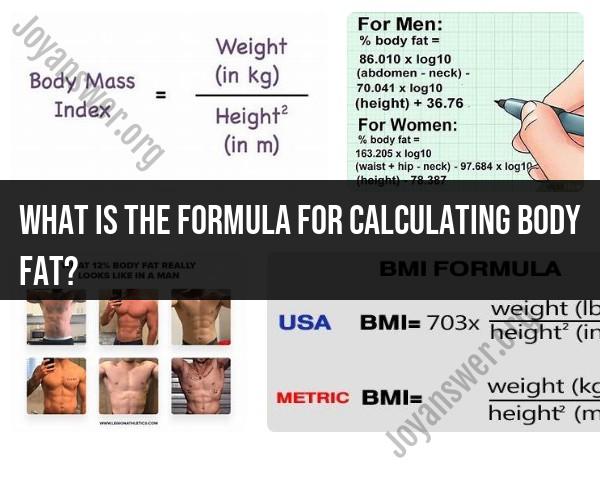What is the formula for calculating body fat?
There are various methods for calculating body fat percentage, ranging from simple measurements to more complex techniques involving specialized equipment. The accuracy of these methods can vary. Here are a few common methods and their associated formulas:
Body Mass Index (BMI):
- While not a direct measure of body fat percentage, BMI is often used as an indicator of body fat. It is calculated using the formula:
Bioelectrical Impedance Analysis (BIA):
- BIA measures the resistance of electrical flow through the body, as fat tissue conducts electricity differently than lean tissue. The formula is typically proprietary to the specific BIA device used.
Skinfold Caliper Method:
- Skinfold calipers are used to measure the thickness of skinfolds at various locations on the body. Common sites include the triceps, suprailiac, and abdomen. The Jackson and Pollock formula is commonly used:
Dual-Energy X-ray Absorptiometry (DEXA):
- DEXA is a more advanced method that uses X-rays to measure bone, fat, and lean tissue mass. It provides a highly accurate assessment of body composition.
Hydrostatic Weighing:
- This method involves measuring a person's weight in air and then again while submerged in water. The underwater weight is used to calculate body density, and then body fat percentage is derived. The formula can be complex and involves the density of water and air.
Air Displacement Plethysmography (Bod Pod):
- The Bod Pod measures body volume by assessing air displacement. The body fat percentage is then calculated based on body density. The specific formula used is proprietary to the Bod Pod system.
3D Body Scanning:
- Advanced imaging technologies, such as 3D body scanning, can provide detailed measurements for calculating body fat percentage. The formulas for these methods may be proprietary to the technology used.
It's important to note that no method is 100% accurate, and results can vary based on factors such as hydration, age, and ethnicity. Additionally, individual preferences and circumstances may influence the choice of method. For the most accurate results, consider consulting with a healthcare professional or fitness specialist who can help choose an appropriate method based on your specific needs and circumstances.
Body Fat Formulas and Gender/Age Considerations:
1. Different Formulas:
Yes, there are different formulas for calculating body fat based on gender and age. This is because the distribution of body fat varies between genders and changes throughout life. Here are some commonly used examples:
a) For Everyone:
- Body Mass Index (BMI): BMI is calculated by dividing weight in kilograms by height in meters squared. It is not a direct measure of body fat but can be used as a general indicator for adults.
- Navy Circumference Method: This method uses neck and waist circumference measurements to estimate body fat percentage. It is relatively easy to perform and requires only a measuring tape.
- Bioelectrical Impedance Analysis (BIA): This method uses a low-level electrical current to measure the resistance of body tissues. BIA devices are readily available, but their accuracy can be affected by hydration levels and other factors.
b) Gender-Specific:
- Jackson-Pollock 7-Point Calipers: This method uses skinfold calipers to measure fat thickness at seven different sites on the body. It requires specialized equipment and training but is considered more accurate than other methods.
- Deurenberg Equations: These equations use various anthropometric measurements, including weight, height, age, and sometimes wrist and hip circumference, to estimate body fat percentage. They are gender-specific and provide more accurate results than BMI or BIA alone.
2. Reliability of Body Fat Calculators and Formulas:
The reliability of body fat calculators and formulas can vary depending on the specific method used. Here are some factors to consider:
a) Accuracy:
- Direct methods: Methods like underwater weighing and DEXA scans are considered the most accurate ways to measure body fat, but they are not readily available and can be expensive.
- Indirect methods: Formulas and calculators using anthropometric measurements are less accurate than direct methods. Their accuracy can be further affected by factors like hydration levels, body composition, and individual variability.
b) Limitations:
- Focus on body fat percentage: Body fat percentage alone does not provide a complete picture of health. It is important to consider other factors like fitness level, muscle mass, and overall body composition.
- Individual variability: Different formulas may provide different results for the same person, highlighting the need for cautious interpretation.
c) Recommendations:
- Use multiple methods: Combining different methods, such as BIA and skinfold calipers, can provide a more accurate picture of body fat percentage.
- Consult a professional: For a more precise and personalized assessment, it is best to consult a healthcare professional or a certified personal trainer with expertise in body composition analysis.
Conclusion:
While various formulas and calculators can estimate body fat, they should be used with caution and understanding of their limitations. Combining different methods and seeking professional guidance can provide a more accurate and holistic assessment of body composition.













